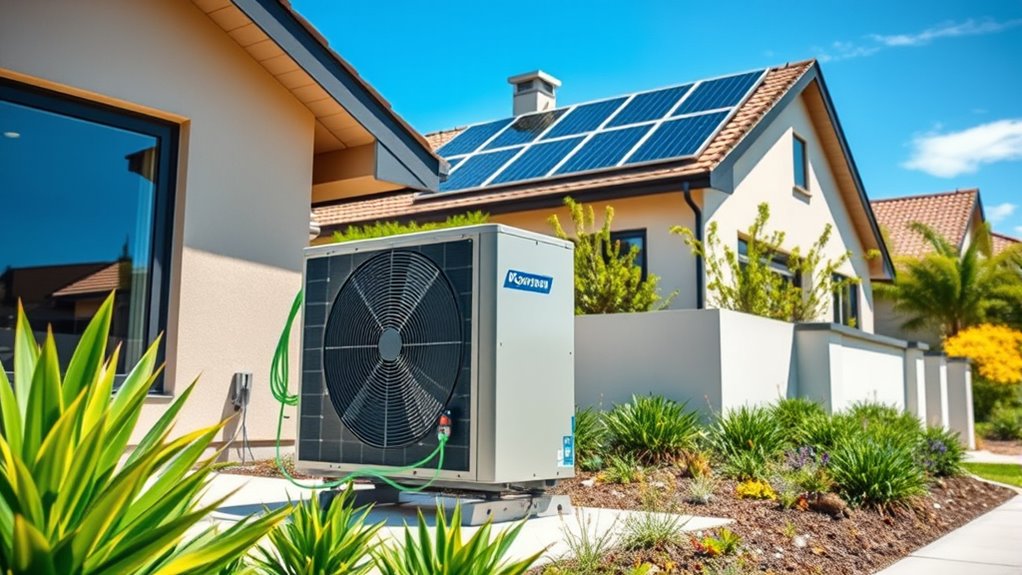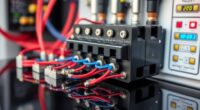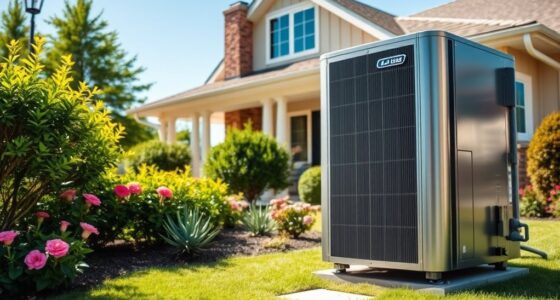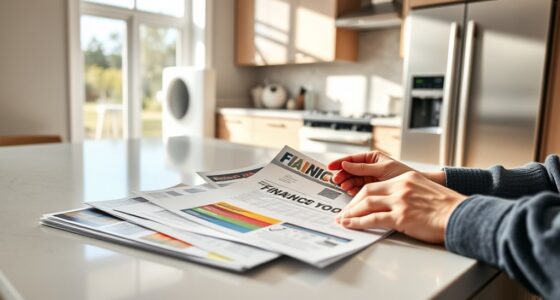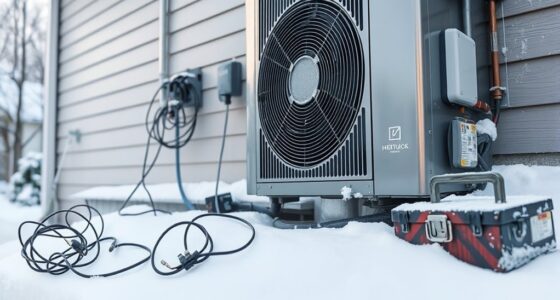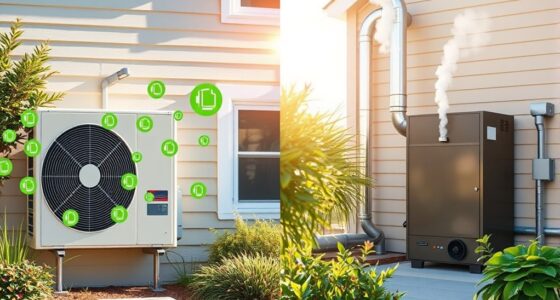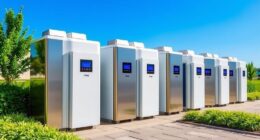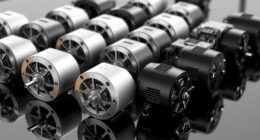Investing in a heat pump can markedly boost your home’s energy efficiency, reducing utility bills over time. With rebates, tax credits, and utility incentives, your initial costs can drop by up to 50%, speeding up your return. While ground source systems cost more upfront, they often save more in the long run and add value to your home. To discover how to maximize your investment and benefits, there’s more to explore ahead.
Key Takeaways
- Incentives and rebates can reduce initial costs by up to 50%, accelerating the payback period.
- Higher efficiency ratings (SEER, HSPF) lead to greater energy savings and faster return on investment.
- Ground source systems have higher upfront costs but offer longer lifespan and greater long-term savings.
- Installing a heat pump can increase home value by up to 3%, boosting overall ROI.
- Proper sizing, maintenance, and leveraging financial incentives maximize system performance and short-term payback.
Understanding the Financial Benefits of Heat Pumps
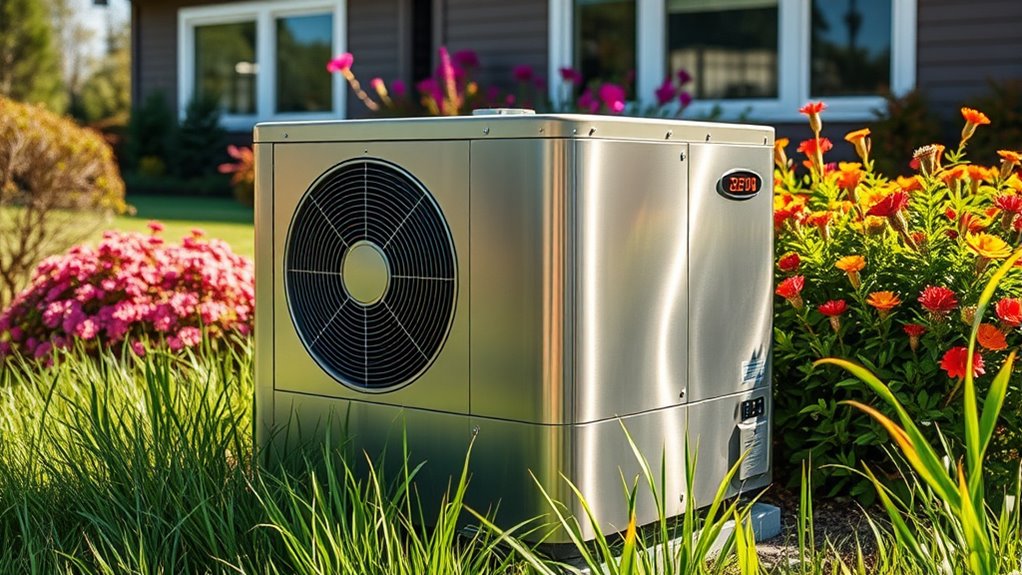
Understanding the financial benefits of heat pumps shows that they can substantially reduce your energy costs over time. A high-efficiency heat pump improves energy efficiency, leading to significant energy savings and lower utility bills. Although the initial investment ranges from $4,500 to $15,000, rebates, incentives, and tax credits can cut installation costs by up to 50%, boosting your ROI. With annual energy costs around $477, long-term savings become clear as you pay less month-to-month. Plus, a heat pump’s lifespan of about 18 years means you can enjoy consistent savings and increased home value over time. Investing wisely in a heat pump not only enhances comfort but also delivers a solid return through reduced utility bills and improved home resale potential. Additionally, understanding energy efficiency and the technological advancements behind heat pumps can help you make more informed decisions about your investment. Proper installation and ongoing maintenance are essential to maximize performance and longevity, ensuring you get the most out of your investment. Regularly monitoring your system’s airflow and filtration can further enhance efficiency and extend its lifespan. Incorporating advanced control systems can also optimize operation and further reduce energy consumption. Moreover, staying informed about technological innovations in heat pump technology can help you select the most efficient and cost-effective models available.
Factors Influencing the Payback Period and ROI

Several key factors determine how quickly you’ll see a return on your heat pump investment. Efficiency plays a major role; higher SEER and HSPF ratings boost performance and reduce energy consumption, shortening the payback period. Upfront costs, including system costs and installation, are critical—rebates, incentives, and tax credits can cut these costs by up to 50%, considerably improving ROI. Climate factors impact savings: colder climates increase energy use, extending payback, while milder climates enable quicker returns. Energy prices also influence payback, as rising costs make heat pump savings more valuable. Choosing a system suited to your climate and maximizing rebates will help you achieve the best ROI, reducing the time it takes for your investment to pay off. Additionally, understanding the refrigeration cycle can help in selecting more efficient systems and optimizing performance over time. A thorough grasp of system efficiency principles allows for better decision-making and system tuning, similar to Kia tuning techniques such as ECU remapping and performance upgrades that serve as an analogy for fine-tuning your system for maximum efficiency and ROI. Being aware of noise levels can also influence satisfaction and long-term investment value, especially in noise-sensitive environments. Moreover, considering the cybersecurity aspects of modern heat pumps ensures protection against potential vulnerabilities in connected systems.
Comparing Costs and Savings: Air Source vs. Ground Source Systems
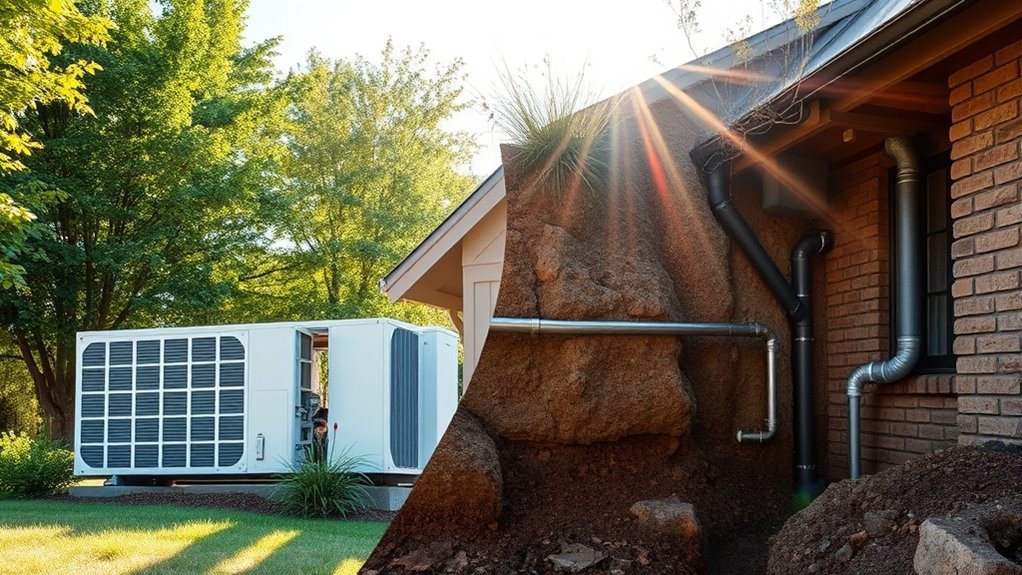
When comparing air source and ground source heat pumps, you’ll want to think about both installation costs and long-term savings. Ground systems have higher upfront expenses but often reduce energy bills more over time, especially in cold climates. Understanding these factors helps you choose the most cost-effective option for your home. Additionally, considering renewable energy sources such as wave and wind energy can provide insights into sustainable power options that complement heat pump systems and enhance overall energy efficiency.
Installation Expenses and Benefits
Installing a ground source heat pump typically costs $10,000 or more more than an air source system, mainly because of the expensive underground loop field. This higher initial expense impacts your overall installation costs and influences your ROI. While ground source systems offer greater efficiency and consistent energy savings year-round, their upfront investment is significant. The increased efficiency can lead to long-term benefits, but the payback period is often longer due to the high initial expense. In contrast, air source heat pumps have lower installation costs, making them more cost-effective and accessible for many homeowners. Although their energy savings are slightly less, the shorter payback period enhances their practicality. Additionally, the installation complexity of ground source systems may require specialized contractors, which can further increase costs. Proper system design and site assessment are crucial for maximizing performance and ensuring a successful installation. Considering local climate conditions can also influence the choice between systems for optimal efficiency. Evaluating the initial investment against projected energy savings helps in making an informed decision. Ultimately, your choice depends on balancing upfront costs with long-term benefits and overall cost-effectiveness. Furthermore, understanding long-term maintenance requirements can impact the overall ROI of each system type.
Long-term Cost Effectiveness
Although ground source heat pumps have higher upfront costs—often exceeding $10,000—they typically save only 10-20% more energy annually than air source systems. This affects their long-term cost-effectiveness and ROI. Consider these points:
- The initial investment for ground source units is markedly higher, impacting your payback period.
- Their extended lifespan (up to 50 years) can offset upfront costs, but the incremental energy savings are often minimal.
- Installation costs for ground systems are higher due to complexity, reducing long-term savings.
- In typical climates, air source heat pumps offer better efficiency and quicker return, making them more cost-effective overall.
- Additionally, climate considerations play a significant role in determining the most suitable system, influencing both performance and savings.
Evaluating climate impact and long-term savings helps determine whether the higher upfront costs of ground source systems are justified for your situation.
Impact of Incentives, Rebates, and Tax Credits on Investment Returns
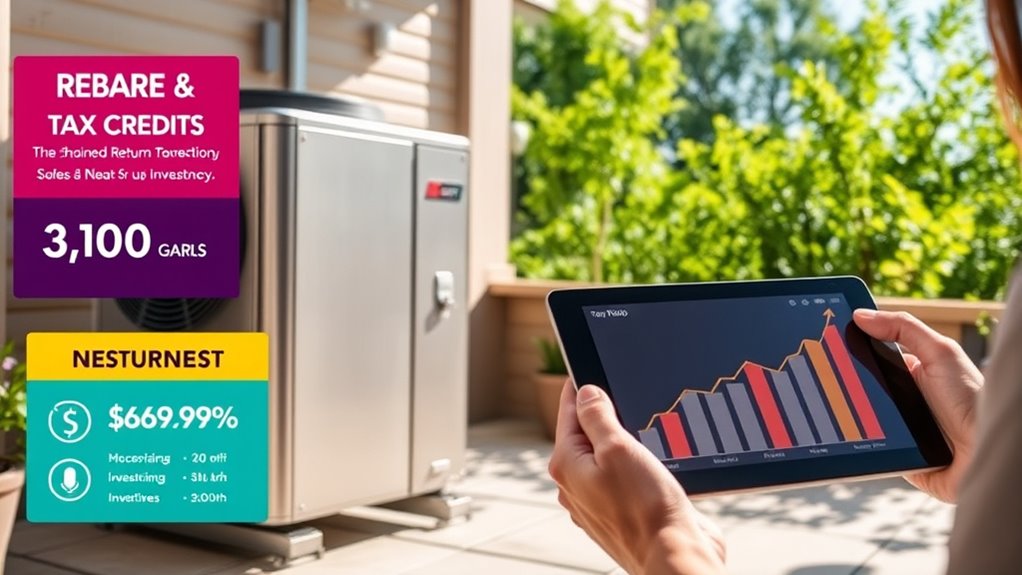
Taking advantage of rebates and tax credits can dramatically lower your initial costs for a heat pump, sometimes by half or more. These incentives often stack from federal, state,, and local programs, maximizing your savings. By understanding and qualifying for these benefits, you can boost your investment’s return and see quicker savings on your energy bills.
Rebate Program Benefits
Have you considered how incentives and rebates can boost your heat pump investment? These programs can notably enhance your financial benefits and shorten your ROI timeline. Here are some key points:
- Rebate programs like California’s $3,000 incentive or Massachusetts’ rebates cut down your net cost.
- Federal tax credits can cover up to 30% of installation costs, adding to your financial savings.
- Many incentives are stackable, letting you combine benefits for maximum cost savings.
- Assistance with rebate paperwork and eligibility ensures you don’t miss out on potential incentives, streamlining the process.
- Understanding incentive programs can help you maximize your return on investment and make informed decisions about your heat pump system.
- Staying informed about regulatory compliance can help you avoid potential hurdles when applying for incentives and ensure your system meets all necessary standards.
- Keeping up with sound design principles can improve the overall efficiency and performance of your system, potentially qualifying you for additional incentives.
- Familiarity with renewable energy technologies can also open up additional funding opportunities and enhance your system’s benefits. Additionally, participating in remote hackathons can provide innovative ideas and solutions for optimizing energy systems and integrating renewable technologies into your home.
Tax Credit Advantages
Maximizing your heat pump investment hinges on understanding how tax credits and rebates work together to reduce upfront costs. These financial incentives boost your investment savings, enhance energy efficiency, and improve your ROI. Federal tax credits can cover up to 30% of installation costs, while state and utility rebates stack with federal incentives, further lowering net expenses. Keep in mind, maximum limits like $2,000 or $4,000 can considerably cut your upfront costs, accelerating your return. Combining multiple incentives is common and can lead to substantial reduction in total investment. Here’s how incentives stack:
| Incentive Type | Typical Coverage | Maximum Limit |
|---|---|---|
| Federal Tax Credit | Up to 30% of installation costs | Varies |
| State Rebate | $3,000+ (California) | $2,000–$4,000 |
| Utility Rebate | Additional cash-back or credits | Varies |
| Stackability | Multiple incentives combine | Yes |
| Impact on ROI | Faster return, lower upfront costs | Notably |
Long-Term Value: Enhancing Home Equity and Market Appeal
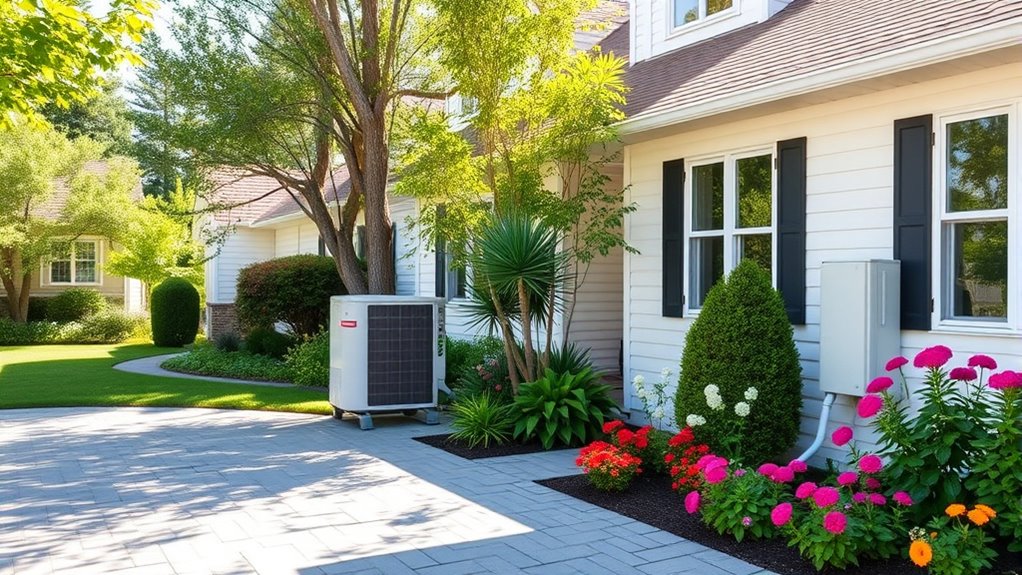
Installing a heat pump can substantially boost your home’s long-term value by increasing its market worth by up to 3%, translating to an extra $10,000 to $17,000. Its long lifespan, often over 20 years, helps sustain your home equity and market appeal. Plus, the enhanced energy efficiency reduces utility bills, making your property more attractive to eco-conscious buyers. Modern heat pumps also improve indoor comfort and aesthetic appeal, further elevating your home’s marketability. To maximize long-term value: 1. Boosts property value and home resale potential 2. Enhances market appeal with energy-efficient upgrades 3. Sustains home equity through durable systems 4. Offers a strong investment return over time. Implementing sustainable upgrades can further reinforce your property’s long-term investment potential and appeal, especially as AI-driven diagnostics continue to improve home maintenance and efficiency. Additionally, incorporating energy-efficient technologies like heat pumps aligns with the growing demand for environmentally friendly homes, further increasing your property’s attractiveness.
Practical Considerations for Maximizing Your Heat Pump Investment
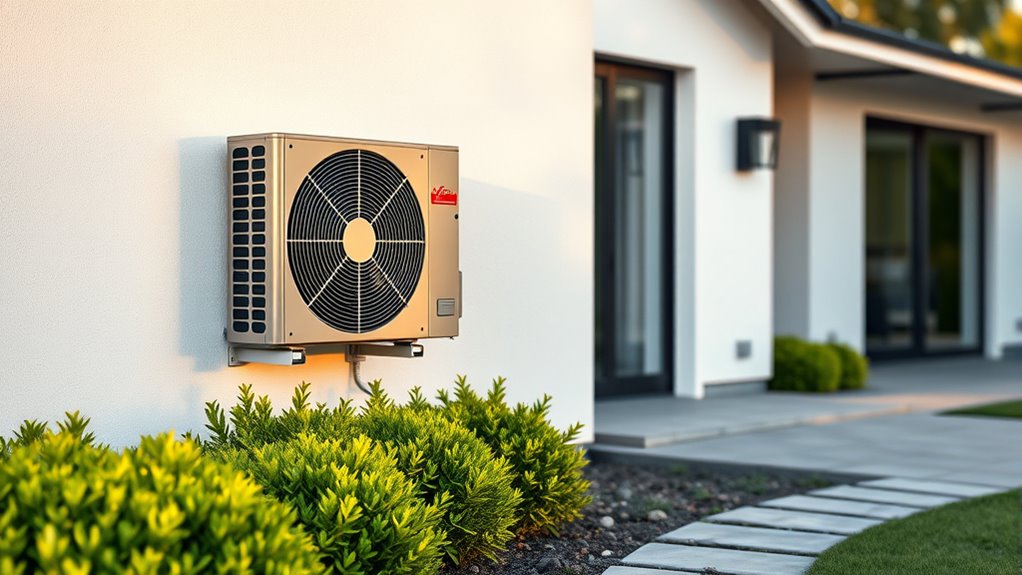
To guarantee your heat pump delivers on its long-term value, paying attention to practical considerations can make a vital difference. Proper system sizing is essential; an accurately sized unit ensures peak efficiency, reducing operational costs and extending equipment lifespan. Regular maintenance, including annual inspections and filter changes, helps sustain system efficiency and prolongs its life. Improving insulation and sealing leaks can notably boost energy savings and ROI by decreasing the workload on your heat pump. Leveraging rebates and incentives lowers initial installation costs, quickening your payback period. Additionally, consulting with HVAC professionals ensures your system choice and installation are tailored to your home’s climate and usage, maximizing overall ROI. These practical steps help maximize your investment and ensure consistent performance.
Frequently Asked Questions
What Is the ROI on a Heat Pump?
You wonder about the ROI of a heat pump. Typically, you’ll see a payback period of around 10 years, thanks to energy savings that can be between $459 and $948 annually. Incentives and rebates help cut upfront costs, making the investment more attractive. Over its 20-year lifespan, you’ll enjoy long-term savings, especially if your climate and energy prices favor efficient heating and cooling.
Are Heat Pumps Worth the Investment?
You’re wondering if heat pumps are worth it. Considering their long lifespan of about 18 years, potential energy savings, and increased home value, they generally are a smart investment. With financial incentives, rebates, and lower operating costs, you can see quicker payback times. Plus, they’re environmentally friendly, reducing your carbon footprint. Overall, a heat pump can provide reliable, cost-effective heating and cooling, making it a worthwhile choice for your home.
What Is the Average Payback for a Heat Pump?
Imagine slashing your energy bills so dramatically that your monthly savings feel like winning the lottery every year. The average payback for a heat pump system is about 8 to 15 years, with most homeowners recouping their investment in roughly 10 years through lower bills. Incentives and rebates can cut this time even further, making the investment more attractive. Over its lifespan, a heat pump’s benefits truly shine.
How Long Until a Heat Pump Pays for Itself?
You’re wondering how long it takes for a heat pump to pay for itself. Typically, it’s between 10 and 15 years, depending on factors like installation costs, energy savings, and local utility rates. With incentives or rebates, you can shorten that period. Since most heat pumps last 15-20 years, you’ll likely see savings during their lifespan, making it a worthwhile long-term investment.
Why Don’t Contractors Like Heat Pumps?
You might wonder why contractors shy away from heat pumps, and the answer’s pretty clear—they’re stuck in the past! Many see traditional systems as safer, more profitable, and easier to install, while heat pumps seem like uncharted territory filled with higher costs, tricky training, and colder climate doubts. This fear of the unknown keeps contractors from embracing the future of HVAC, even when heat pumps could save your wallet big time.
Conclusion
Considering the long-term savings, incentives, and increased home value, investing in a heat pump can be a smart move. With proper planning, you’ll maximize your investment and enjoy efficient comfort for years to come. Isn’t it worth asking yourself if now’s the time to upgrade your home’s heating and cooling system for better savings and sustainability? Make an informed decision today—your future self will thank you.
